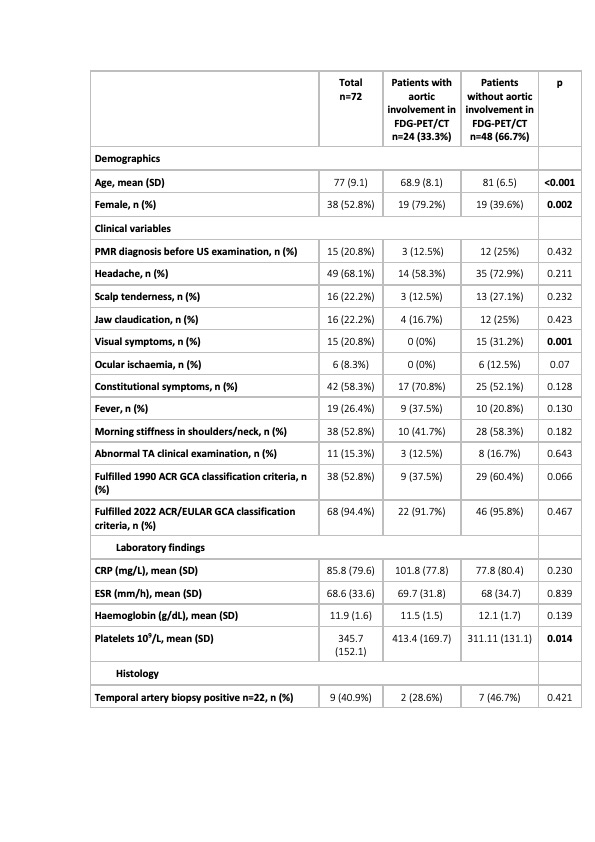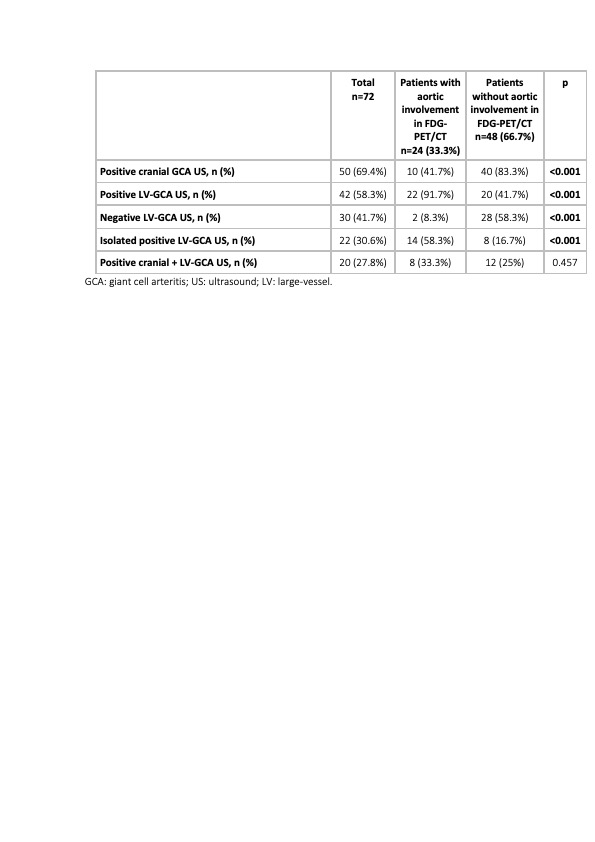Session Information
Session Type: Poster Session B
Session Time: 9:00AM-11:00AM
Background/Purpose: Aortitis is a serious potential complication of patients with giant cell arteritis (GCA) and may lead to dilation, aneurysms or dissection. Since ultrasound (US) has limited access to detect aortitis, comparative studies with other imaging modalities to determine the clinical impact of this limitation and the specific situations warranting their use are needed. Our aim was to determine the impact of US intrinsic limitation to assess aortitis vs FDG-PET/CT in patients with US-proven GCA and to identify factors associated with aortic involvement.
Methods: Retrospective observational study of patients referred to US fast-track clinics at two academic centres over a four-year period. Only patients with GCA confirmed by US were included. Temporal (TA) and extracranial arteries US were performed at baseline. FDG-PET/CT was performed according to clinician’s criteria. An FDG artery uptake at the aorta higher than liver uptake was considered positive for aortitis.
Results: Seventy-two of 186 patients with US-proven GCA underwent an FDG-PET/CT; 29 (40.3%) had a positive FDG-PET/CT and 24 (33.3%) presented aortitis. Only 6 (20.7%) patients with positive FDG-PET/CT had negative US findings of large vessel (LV)-GCA. Among patients with aortitis in FDG-PET/CT, only 2 (8.3%) had negative US findings of LV-GCA. Patients with aortitis were younger (68.9 vs 81;p< 0.001), more frequently females (79.2% vs 39.6%;p=0.002) and had higher platelets count (413.4 vs 311.1;p=0014) (Table 1). Patients with aortitis presented positive TA US less frequently (41.7% vs 83.3%;p< 0.001), but more LV US involvement (91.7% vs 41.7%; p< 0.001) versus patients without aortitis (Table 2). None of the patients with aortitis exhibited visual symptoms (0% vs31.2%;p=0.001).
Conclusion: FDG-PET/CT can detect aortitis in 1 out of every 3 patients with US-proven GCA. However, a negative US examination for LV-GCA suggests a low risk of aortitis. Younger and female GCA patients with thrombocytosis, absence of visual manifestations and LV-GCA on US may more frequently present aortitis by FDG-PET/CT.
To cite this abstract in AMA style:
Molina-Collada J, Castrejon I, Monjo I, Fernandez-Fernandez E, Torres G, MARTINEZ BARRIO J, Alvaro-Gracias J, De Miguel E. Impact of Ultrasound Limitation to Assess Aortitis in Patients with Giant Cell Arteritis: Comparative Study with FDG-PET/CT [abstract]. Arthritis Rheumatol. 2023; 75 (suppl 9). https://acrabstracts.org/abstract/impact-of-ultrasound-limitation-to-assess-aortitis-in-patients-with-giant-cell-arteritis-comparative-study-with-fdg-pet-ct/. Accessed .« Back to ACR Convergence 2023
ACR Meeting Abstracts - https://acrabstracts.org/abstract/impact-of-ultrasound-limitation-to-assess-aortitis-in-patients-with-giant-cell-arteritis-comparative-study-with-fdg-pet-ct/


